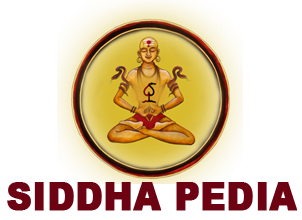Tamravaktra Jwal
Tāmravaktra is a revered deity within Siddha Dharma, belonging to the Jwāla Gana of Swachhanda bhairav Shiva. Tāmravaktra” (Sanskrit: ताम्रवक्त्र) is a compound Sanskrit word made up of:
Taamra (ताम्र) – meaning copper, reddish, or red-bronze in color
Vaktra (वक्त्र) – meaning face, mouth, or sometimes speech
So, Tāmravaktra literally means “one with a copper-colored face” or “reddish-faced. He is a Shiva Gana with a coppery or fiery reddish face – symbolizing power, radiance, or sometimes wrath.
Known for his fierce temperament, copper-colored face, and intense fiery aura, he symbolizes both protective and destructive power. In deshaj parampara of some himalayan regions bhagwaan tamravaktra is also recognised by many names.
As Jwāla he is categorized under Shiva’s entourage. All of these are essentially Shiva or partial avatar of Shiva. They are categorized under Bhairava or Gana or as Jwāla.
The Jwāla category is particularly significant, comprising beings born directly from Swachhanda bhairav Shiva’s fiery essence, responsible for maintaining cosmic energies, stability and guhiya vidya(hidden knowledge). These entities embody both the protective and destructive aspects of fire (Agni), holding significant power in Tantra’s hidden traditions.
Tāmravaktra Jwāla is a powerful, revered figure in Siddha Dharma and broader Tantra traditions, embodying the intense duality of creation and destruction, protection and vengeance, deeply enmeshed in both spiritual and cultural narratives across Asia.
Origin
Contents
There are three different stories of origin of Tāmravaktra Jwāla. According to Mahasiddha Koshira Nath, when the universe was first created, various forms of consciousness (Chetanās) began to manifest across different realms of existence. During this cosmic unfolding, Bhagavatī Yogamāyā began imparting the knowledge and mysteries of the universe to all sentient beings.
At that profound moment, Bhagavān Svacchanda Bhairava Śiva created three supremely secret and sacred scriptures, collectively known as the “Traya Guhya Tantra Grantha Mālā” (The Triple Esoteric Tantra Texts). These texts were intended only for those beings who embodied the highest divine wisdom and spiritual merit.
To safeguard these granthas and the powerful sādhana systems they contain from inferior, vile, and demonic entities, Bhagavān Svacchanda Bhairava emanated nine Jwāla Gaṇas—divine radiant beings—formed from his own Teja (spiritual radiance). Among these, Tamravaktra Jvāla was appointed as the foremost and the guardian-in-chief.
Whenever a sādhaka attains a specific elevated state of consciousness through the sādhana of Bhagavān Svacchanda Bhairava or Devī Bhagavatī Kurukullā, the doors to these hidden and esoteric granthas are mystically opened by Tamravaktra Jvāla. Furthermore, Bhagavān Śiva granted Tamravaktra a boon: that whenever a true sādhaka reaches a certain inner threshold on the path of realization, Tamravaktra Jvāla may bless them with the capacity to receive and comprehend the sacred knowledge enshrined in these Tantra texts.
To this day, Tamravaktra Jvāla continues to guard these scriptures in the form of a divine, luminous force of protective light, ensuring that their secrets remain preserved and accessible only to the worthy.
The second origin story is According to Siddha dharma, when Bhagwan Swachhanda Bhairava Shiva was imparting the supreme knowledge of tantras to Devi Yogmaya Kurukulla, he mentioned about the deity who resides in the form of light safegaurding the hidden tantras provided by Shiva himself. bhagwan Shiva asked Bhagwati to close the eyes and then Bhagwati yogmaya started seeing the creation of whole universe and all the divine forms in it, then Bhagwati asked “Who is the deity whose brilliance illuminates the hidden caves and tunnels within the cosmos, whose radiance reflects endlessly like mirrors facing each other, creating infinite tunnels of light?”
Bhagwaan Swachhanda Bhairava Shiva revealed that this radiant energy is his own secret potency—the Guhya Shakti—in which the Jwāla resides protecting the supreme and highly secretive tantra knowledge. These cosmic flames (Jwāla) channel the hidden energies and mysteries of the universe, manifesting during the creation when the cosmic whirlpool (Bhavar Chakravaat) appeared. Tāmravaktra Jwāla presides over this immense cosmic vortex, immovable and steady like a kilaka (peg), anchoring universal order.
After this Jwāla Ganas appeared before Bhagwati maa Yogmaya and she imbibed the secret knowledge of the supreme tantra systems. Then Maa Yogmaya passed on this knowledge system to the Mahasiddhas at the great Mount Kailash.
In ancient times when Mahasiddha were travelling around in the great Mount Kailash, The leader of some daityas known as Vajrabuddha daityas seeing the immense spiritual powers of the Mahasiddhas started pestering them with the intention of killing them and capturing their spiritual powers. These daityas wanted to capture the siddha dharma and modify it to create their own dark and tamsic dharma. But the divinity and high spiritual energy of Mahasiddhas made it difficult for these daityas to succeed in their mission. They then gathered all their powers to kill and stop the Mahasiddhas. When these Vajrabuddha daityas (demonic beings) arrived, they arrogantly addressed to the Mahāsiddhas, saying, “Look at your so-called Brahmā, Viṣṇu, Maheśa (Śiva), and Kāma (Kandarpa) — none of them possess the power to liberate you. In fact, they deliberately prevent your liberation, binding you in the endless cycle of birth and rebirth.”
Hearing this and witnessing their audacity, the Mahāsiddhas invoked Bhagwan Swachhanda bhairav Shiv with utmost devotion and concentration. Responding to their sacred call, Shiva’s gana Tāmravaktra Jvāla, manifested in a blazing form of divine wrath.
With force of just a single finger, Tāmravaktra Jwāla casted them in the Pataal loka. Many of the daityas were instantly reduced to ashes by his blinding radiance, some were consumed in smoke, and others perished under the weight of his fiery energy. Tāmravaktra also snatched away their capacity of rebirths so that they cannot harm the righteous ones ever. And thus the righteousness was again established.
| SL No. | Image | Name of the Mahasiddhas (English) | Name of the Mahasiddhas (Hindi) |
|---|---|---|---|
| 1 |  | Mahāsiddha Koshira Nath Ji | महासिद्ध कोशिर नाथ जी |
| 2 | 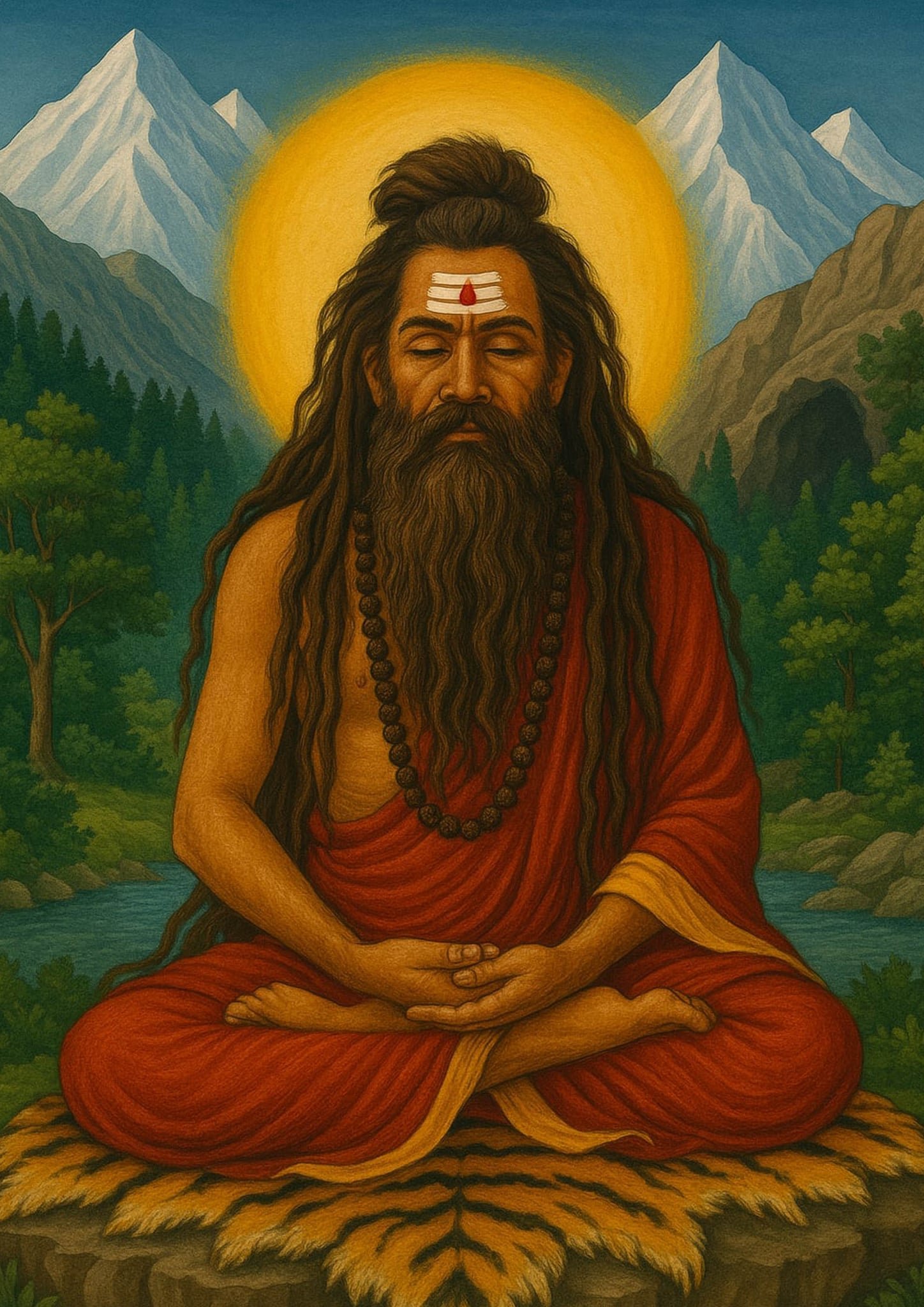 | Mahāsiddha Mahichetan Nath Ji | महासिद्ध महिचेतन नाथ जी |
| 3 | 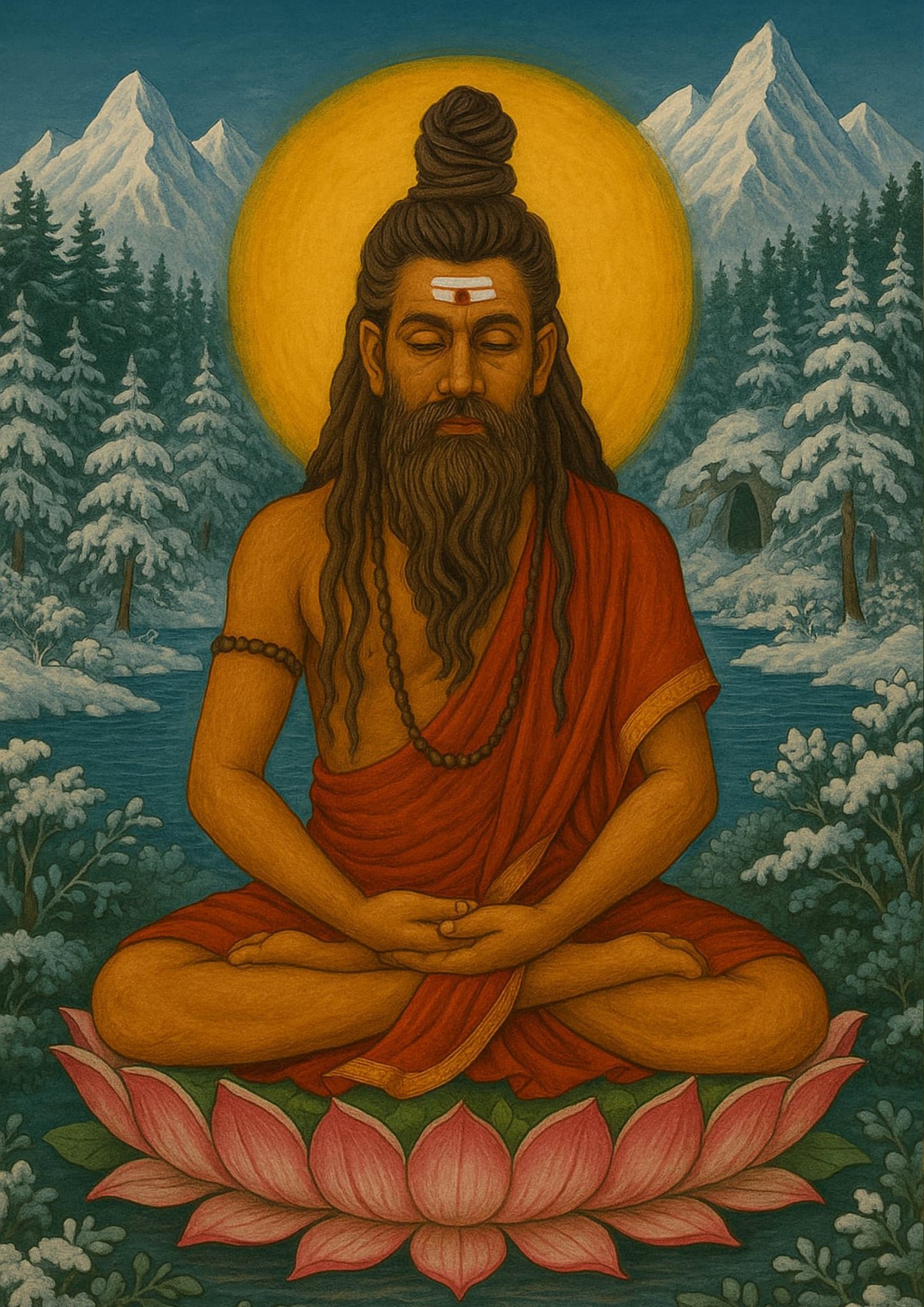 | Mahāsiddha Ashwamula Nath Ji | महासिद्ध अश्वमूल नाथ जी |
| 4 |  | Mahāsiddha Satya Madan Nath Ji | महासिद्ध सत्य मदन नाथ जी |
| 5 |  | Mahāsiddha Abhoot Nath Ji | महासिद्ध अभूत नाथ जी |
| 6 | 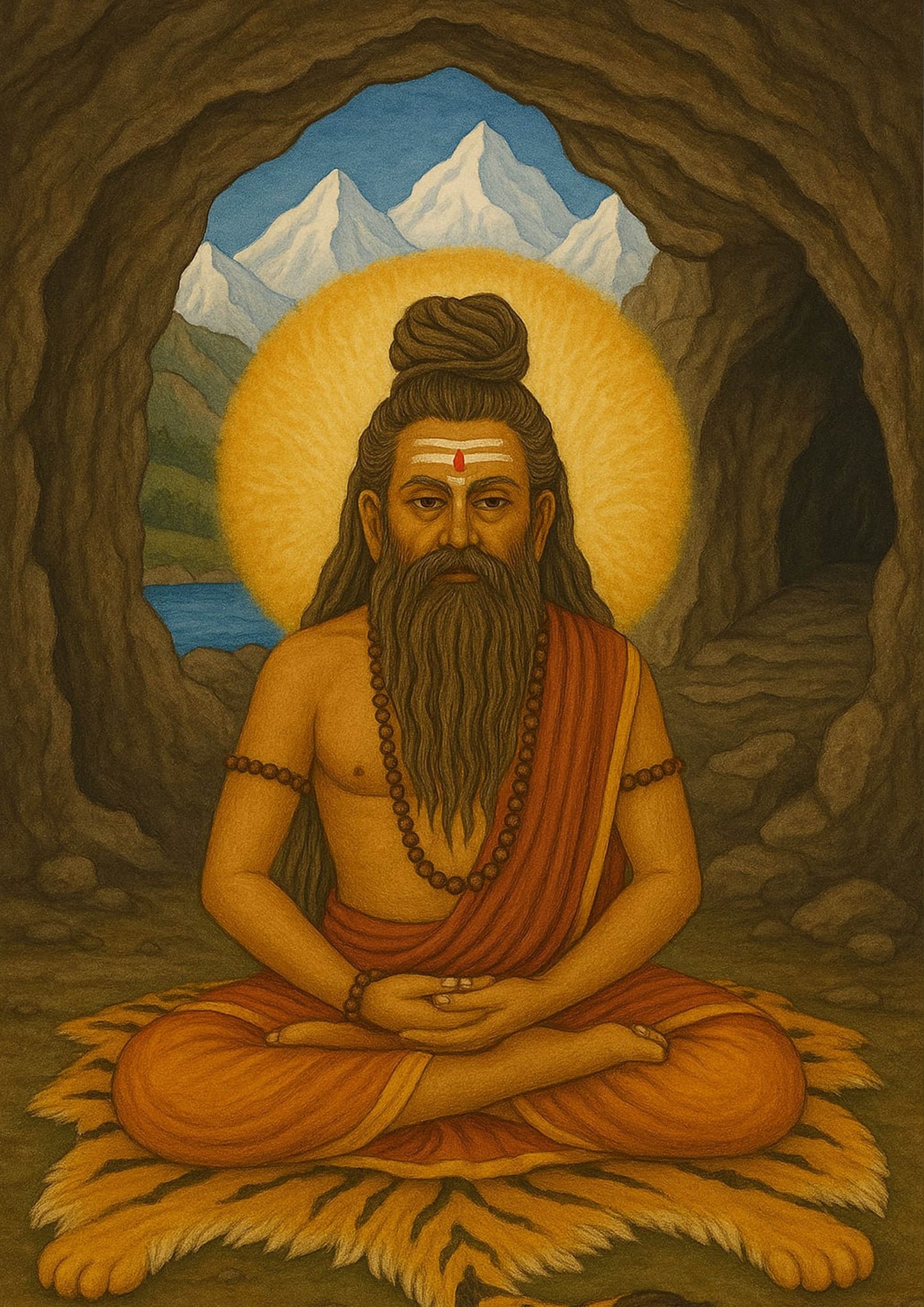 | Mahāsiddha Madrabinda Nath Ji | महासिद्ध मद्रबिन्द नाथ जी |
| 7 | 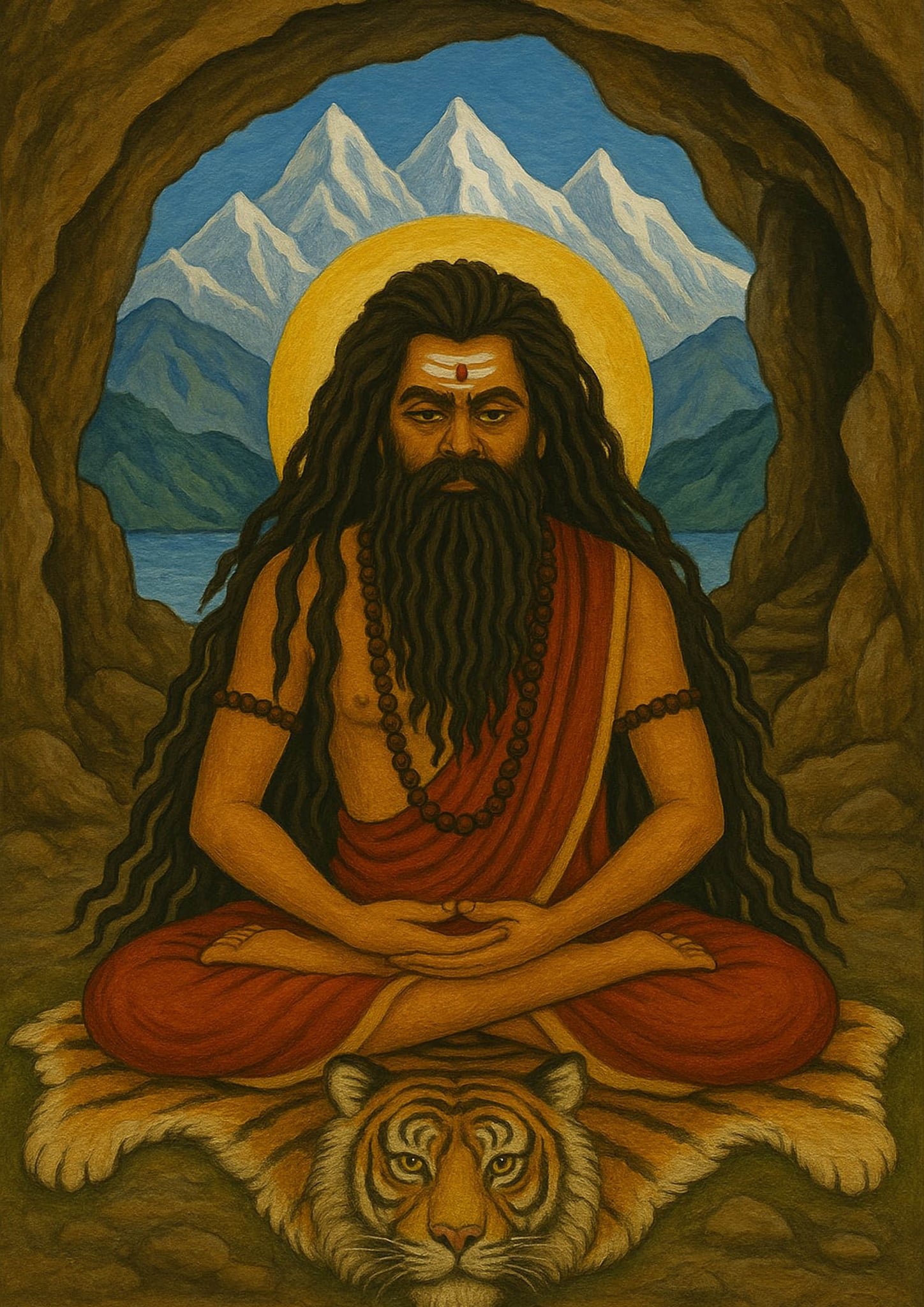 | Mahāsiddha Pravina Suta Nath Ji | महासिद्ध प्रवीण सुत नाथ जी |
Form and Iconography
Tāmravaktra Jwāla is visually represented as fierce and fearsome:
He is the fierce guardian born of divine radiance of Bhagwan Swachchhanda bhairava Shiv, stands as the blazing embodiment of wrathful protection and tantric power. His very form is a manifestation of cosmic balance between the divine and the demonic forces.
In moments of divine wrath, one of his massive teeth pierces upward, like a dagger ascending toward the skies—symbolizing his defiance and authority over the celestial beings. The other tooth juts downward, fierce and rooted, plunging into the depths of Pātāla, asserting dominion over the dark and taamsic forces that dwell there. This asymmetry signifies his role as the destroyer of imbalance.
His eyes, burning with otherworldly intensity, reflect his transcendental perception:
The right eye turns upward, eternally fixed on Swarga (heaven), absorbing the subtle signals of the Devas, the higher realms, and cosmic laws.
The left eye glares downward, unflinching in its watch over Pātāla (netherworld), where asuras, daityas and highly malevolent forces like Vajrabuddha daityas reside. This dual gaze keeps the forces of both realms in check, preventing either from overpowering the balance of existence.
His ears mirror this divine duality—
One ear is attuned to the celestial harmonies of the higher lokas, absorbing the sacred vibrations of mantras, divine calls, and siddhic truths.
The other ear is ever alert to the agonies, cries, and deceptions of the infernal planes, ensuring that no demonic whisper goes unheard.
Tāmravaktra’s arms stretch wide across the universe, as if embracing the totality of existence.
One arm reaches upward toward the skies, invoking protection for the pure-hearted seekers, saints, and yogis striving for liberation.
The other arm extends downward into the abyss, ready to drag the corrupt, the egoic, and the destructive forces back into the fires of transformation.
He is the cosmic firewall, the untamed flame that burns through illusion, ego, and imbalance. In the sacred Himalayan cremation grounds, where worldly attachments dissolve, Tāmravaktra Jwāla stands unmoved, a sentinel of both death and transcendence.
Commonly depicted holding three primary weapons:
Trishool (trident)
Paash (rope), always present that eternally binds the demonic beings like the Vajrabuddha Daityas, holding them in a state of paralysis so that they cannot spread impurity and darkness in the universe.
Khadga (sword) or Khatvaanga (skull-topped staff) symbolising the wrath and aggression against the demonic forces. Whenever any demonic forces tries to create an imbalance in the universe by harming dharma he would kill those forces with his sword.
A notable depiction is his stance atop funeral pyres of demons (asura), barbarians (mleccha), and malevolent beings like Vajrabuddhas (daityas), symbolizing his role as protector of cremation grounds. He has crushed the Vajrabuddha demons beneath his very feet, subjugating them completely and rendering them powerless under his divine force.
The prime nine Jwāla ganas are as mentioned below:
| SL No. | Image | Name of the Mahasiddhas (English) | Name of the Mahasiddhas (Hindi) |
|---|---|---|---|
| 1 |  | Tamravaktra Jwāla | ताम्रवक्त्र ज्वाल |
| 2 |  | Brahmakeela Jwāla | ब्रह्मकील ज्वाल |
| 3 |  | Krurastambha Jwāla | क्रूरस्तम्भ ज्वाल |
| 4 | 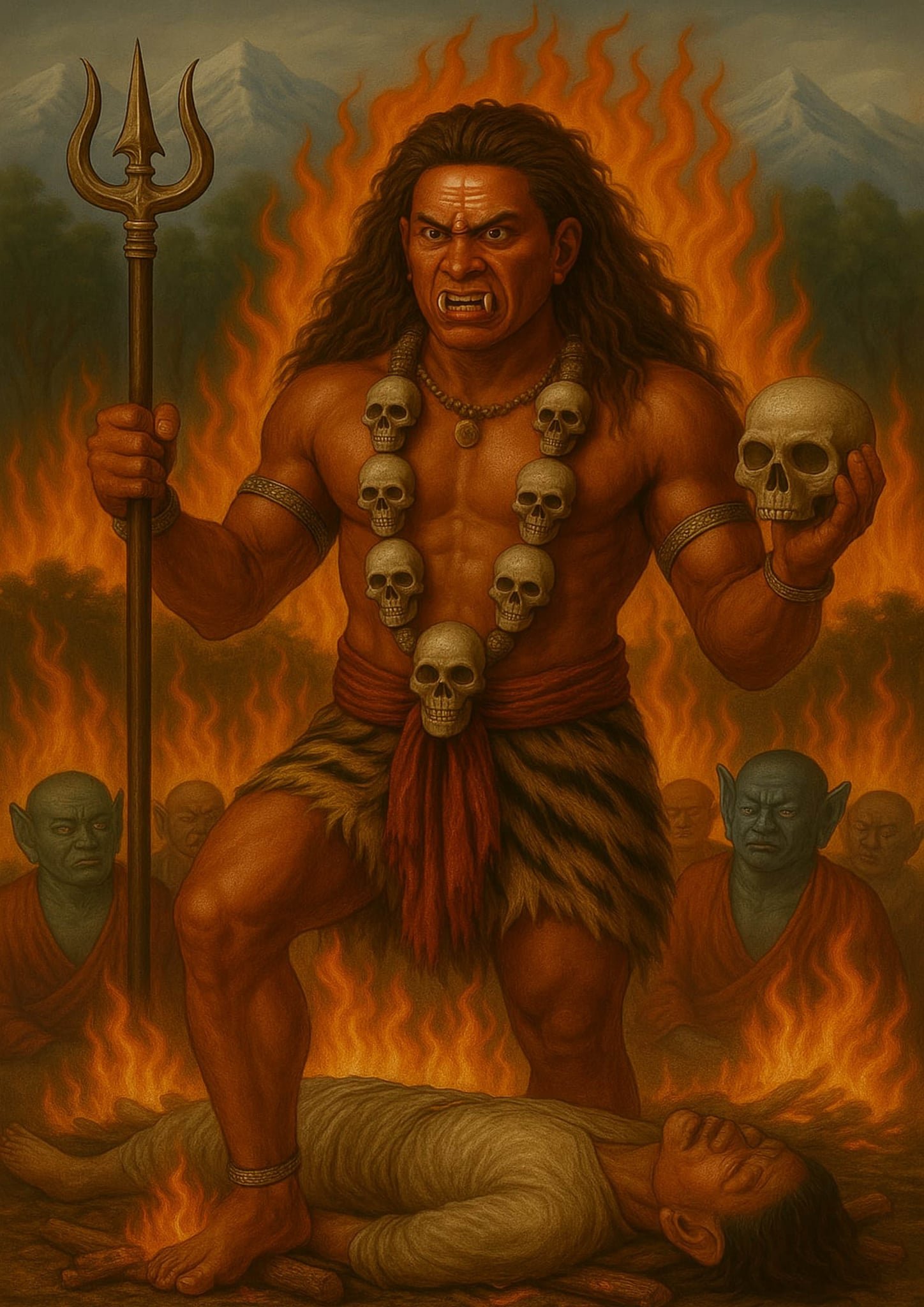 | Kalabeeja Jwāla | कालबीज ज्वाल |
| 5 | 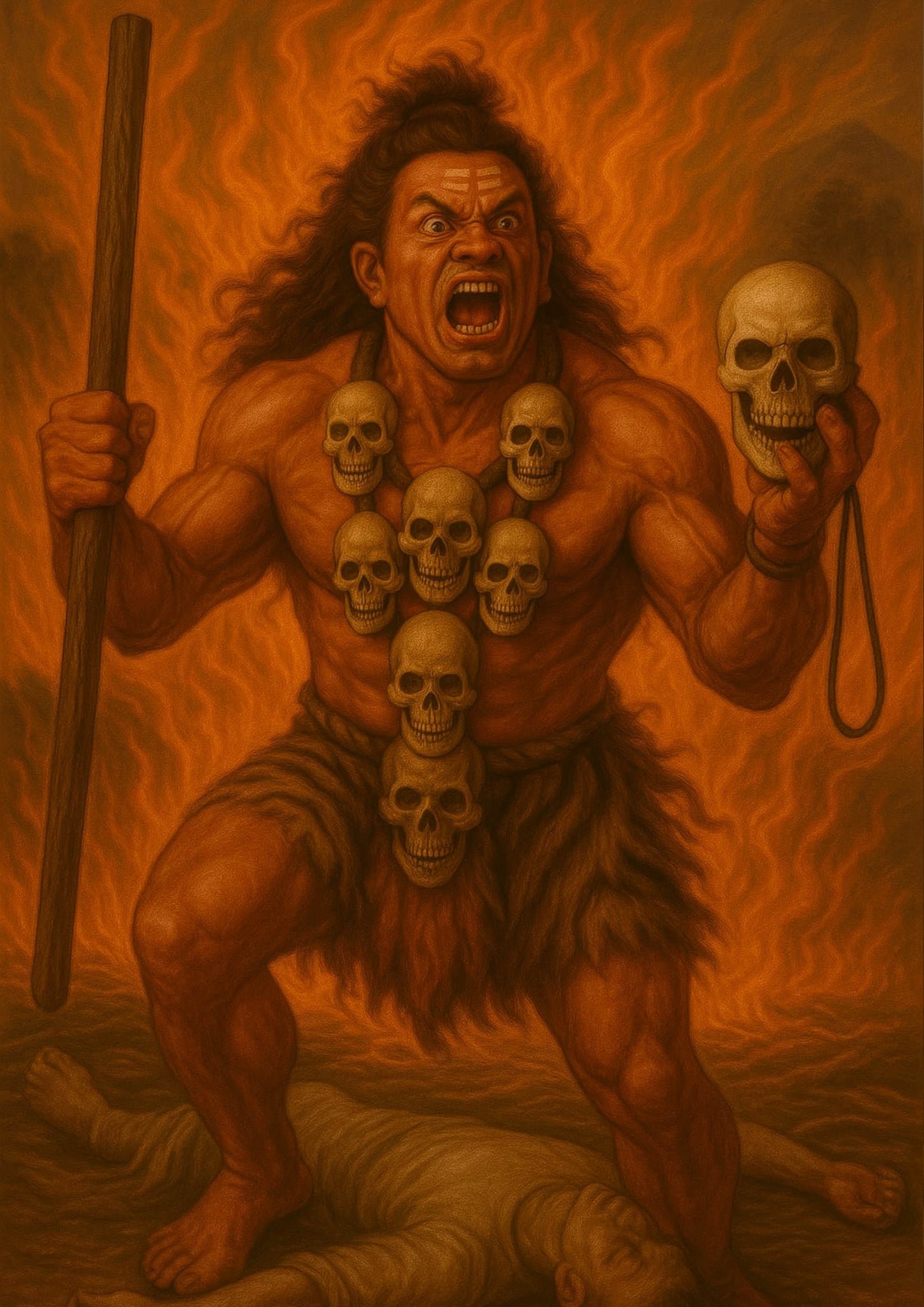 | Dandadhara Jwāla | दण्डधर ज्वाल |
| 6 |  | Ratrimushti Jwāla | रात्रिमुष्टि ज्वाल |
| 7 | 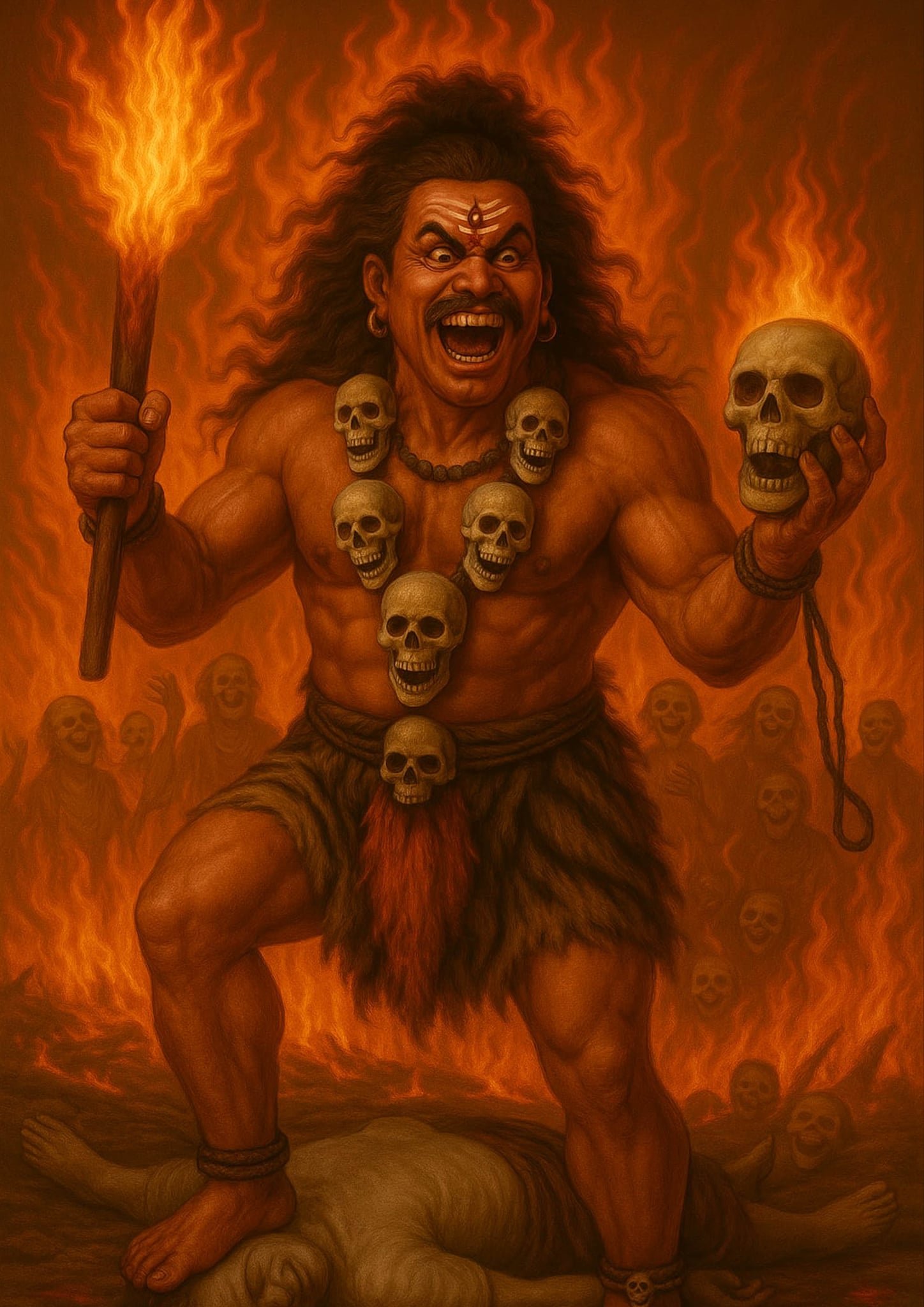 | Bhasmabhu Jwāla | भस्मभू ज्वाल |
| 8 | 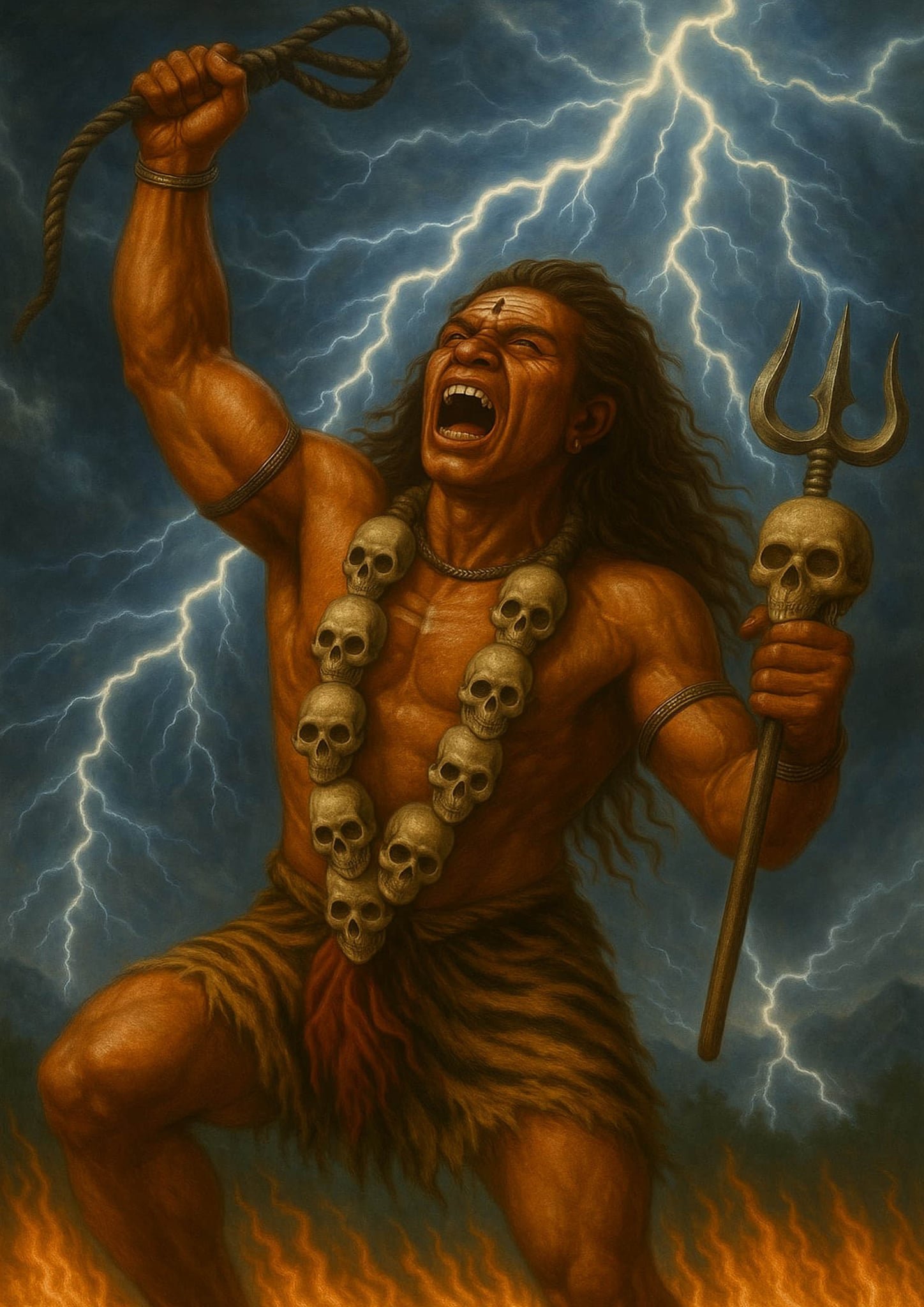 | Bhayakampa Jwāla | भयकम्प ज्वाल
|
| 9 |  | Mrityuhasa Jwāla | मृत्युहास ज्वाल |
The three forms of Jwālas
| SL No. | Name(IAST) | Name (Devanagari) | Attribute |
|---|---|---|---|
| 1 | Tamasik Jwāla | तामसिक ज्वाल | Fierce, destructive, associated with warfare |
| 2 | Peaceful Jwāla | शांत ज्वाल | Typically calm but unpredictable; capable of both harm and benefit. |
| 3 | Tejomaya Jwāla | तेजोमय ज्वाल | Divine radiance granting wisdom, enlightenment, and cosmic power to devotees. |
Within this esoteric tradition, three principal forms of Jwāla are recognized, each representing a distinct dimension of divine fire:
Tamasic Jwāla – This form is fierce, unrelenting, and destructive. It is invoked in situations of spiritual warfare, internal conflict, or the annihilation of deeply rooted karmic impurities. Tamasic Jwāla is the divine fire that burns obstacles without mercy and clears the path for transformation through destruction.
Peaceful Jwāla – Despite its name, this form of Jwāla is both tranquil and unpredictable. It holds the paradoxical capacity to bless or to curse, to heal or to scorch. It reflects the mysterious nature of spiritual fire that can, like a calm flame, warm or consume—depending on the purity and intention of the practitioner.
Tejomaya Jwāla – The highest and most revered form, Tejomaya Jwāla is the fire of divine brilliance and enlightenment. It radiates with pure spiritual luminosity, bestowing inner wisdom, transcendent insight, and the power to connect with the deepest truths of the cosmos. Devotees aligned with Tejomaya Jwāla experience heightened states of consciousness and direct communion with the sacred forces of the universe.
Beeja and Mantras
The beeja mantra or the seed syllable of Bhagwaan Tāmravaktra Jwāla is “hraim” which is written in sanskrit as ” ह्रैं ”
There are many mantras of Bhagwān Tāmravaktra Jwāla mentioned in the Tāmrawaktra Jwāla tantra. Of them the three main or primary mantras are made available for the general people.
The first mantra mentioned in the Tāmrawaktra Jwāla tantra is called as Siddha mantra.
The second mantra is known as the laghu mantra or the short mantra of Bhagwān Tāmravaktra Jwāla.
The biggest of the three mantras is the third one that is called the Maha Mantra of Bhagwān Tāmravaktra Jwāla.
Mentioned below are these three mantras:
| SL No. | Mantra (Devanagari) | Mantra(IAST) |
|---|---|---|
| 1 | ॐ नमः चण्ड अतिचण्ड ताम्रवक्त्र ज्वालाय भं ह्रैं ह्रैं त्रट हुं फट | oṁ namaḥ caṇḍa aticaṇḍa tāmravaktra jvālāya bhaṁ hraiṁ hraiṁ trata huṁ phaṭ |
| 2 | ॐ नमः चण्डातिचण्ड ताम्रवक्त्राय ह्रैं हुं फट | oṁ namaḥ caṇḍāticaṇḍa tāmravaktrāya hraiṁ huṁ phaṭ |
| 3 | ॐ ह्रैं क्षौं जं जं हं हं भं भः चण्ड महाचण्ड प्रचण्ड ताम्रवक्त्र-ज्वालाय एहि एहि हं हं हं मं मं त्रीं ह्रैं हुं फट् | oṁ hraiṁ kṣauṁ jaṁ jaṁ haṁ haṁ bhaṁ bhaḥ caṇḍa mahācaṇḍa pracaṇḍa tāmravaktra-jvālāya ehi ehi haṁ haṁ haṁ maṁ maṁ trīṁ hraiṁ huṁ phaṭ |
Tāmravaktra Jwāla Mandala
According to The Kulant Nath Mahāsiddha Ishaputra, the Tāmravaktra Jwāla Maṇḍala is a highly esoteric and sacred geometrical construct, considered a milestone in the Tāmravaktra Jwāla sādhana. Within the Siddha Dharma tradition, this maṇḍala is revealed only to those sādhakas who have proven their worthiness through intense spiritual discipline and inner purification. It is said that the sādhanā of Tāmravaktra Jwāla cannot be initiated without the proper establishment of this maṇḍala within the sādhaka’s place of worship.
Geometrical and Mystical Composition
The structure of the Tāmravaktra Jwāla Maṇḍala is layered with deep spiritual symbolism and precision, forming a yantric gateway for divine invocation:
Three Outer Vṛittas (Circles): The maṇḍala begins with three concentric circles that form its outer boundary. These circles are inscribed with potent bīja mantras in Sanskrit, each chosen for its vibrational resonance and transformative power.
The outermost circle bears the bīja mantra “Hraim” (ह्रैं).
The second circle holds the mantra “Ham” (हं).
The third, innermost circle again repeats the mantra “Hraim”(ह्रैं).
Ākāśa (Sacred Space): Inner to the 3 circles lies the Ākāśa, the ethereal space representing the infinite, formless divine. Within this space, the bīja mantra “Hraim” is once again inscribed, signifying the unbounded radiance of divine awareness.
Four Laghu Maṇḍalas (Miniature Mandalas): Within the Ākāśa reside four smaller mandalas. These laghu maṇḍalas each carry the sacred mantra “Hraim”.
Four Bhūpura Gateways: Surrounding the central space are four Bhūpuras, symbolic gateways through which divine energy is accessed and they are locked via Bhūpura Bandhas—mystical seals that preserve the sanctity and containment of spiritual force.
Sixteen Lotus Petals: Enclosed within Ākāśa there are sixteen lotus-shaped petals, arranged symmetrically—eight petals upward and eight downward. These petals represent divine emanations and transcendental energies, and upon each petal is inscribed the mantra “Hum” (हुं).
The two circles on which the petals rests involve the beeja mantra “hraim”.
Five Sacred Boxes (Kosha): Deep within the central construct are five inner compartments or koshas, each containing specific bīja mantras. These mantras vary in their purpose.
In Siddha dharma the mandalas serve as the deity itself. This Tāmravaktra Jwāla Maṇḍala is not just a diagram—it is a living yantra, a multidimensional blueprint that serves as a channel between the sādhaka and the fierce, radiant presence of Bhagavān Tāmravaktra Jwāla. Its power unfolds only under the guidance of a realized Guru, and its mastery leads to profound awakening, protection from dark forces, and deep access to inner self and siddhic knowledge.
Tāmravaktra Jwāla Keelaka and Kavacha
According to Mahāsiddha Ishaputra In Himalayan Siddha dharma tradition Tāmravaktra Jwāla is considered as a very powerfull deity for keelaka and kavach vidyas.
There are some tantric vidyas related to krityas, guhiyakas, maari ganas and krura kul devas. These vidyas ones brought into effect cannot be reversed or stopped by any means. The only remedy for this is to pause or paralyse the energy by keelaka. The speciality of Tāmravaktra keelaka is that whenever the effect of any vidya is paused using Tāmravaktra keelaka it absorbs the energy of that vidya, though such vidyas can never be destroyed but Tāmravaktra keelaka converts their energy into some other form thereby making them ineffective. This makes Tāmravaktra keelaka most important, unique and very popular among the tantric traditions of himalayan Siddhas and Kaulantak Peeth. Tāmravaktra keelaka is a metallic ritualistic weapon(astra) which looks somewhat like dagger commonly made of Ashtadhatu(an alloy of eight different metals).
In himalayan tradions, the figure of Tāmravaktra keelaka is drawn on Bhoj patra or normal paper or carved in tamra patra(copper sheets) and kept in the places inhabited by negative or dark energies to block or neutralise those energies. Similarly there is another very powerful yantra figure ‘Tāmravaktra kavacha’ which is also drawn in the same way and kept in the places to protect oneself from negative and dark forces and also from the effect of harmful occult practices. Himalayan Mahasiddhas sometimes use both Tāmravaktra keelaka and Tāmravaktra kavacha during the times of their deepest penances and secretive tantric sadhanas to save themselves from some vidyas like Chaura ganapati, shoola vidyadhari, siddhikeshi, kankaalmalini as these vidyas have the power to protect the energies of the sadhak of chaura ganapati but at the same time it also carries the power to steal the tapobal (spiritual energy) and vidyas of another saadhaka. So to protect themselves from such vidyas Mahāsiddhas have always used Tāmravaktra keelkak and kavacha. With the help of these one does not need to worry about such vidyas like chaura ganapati.
Chaura Gaṇapati (also spelled Chaurā Gaṇapati or Chaurya Gaṇapati) is a rare, secretive, and mystical fom manifested from Bhagwān ganesha himself. He was invoked by the devtas to capture the vidyas and energies of asuras and daityas so that they cannot harm others. Chaura Gaṇapati is associated with deshaj (folk), tantric, and wrathful yogic traditions—especially in Siddha Dharma, Kaulachara and Shaiva-Shakta tantric paramparās of himalayas.
According to Mahasiddha Ishaputra Chaura Gaṇapati is a secret guardian, a wrathful protector, often invoked in tantric sādhanās like guhiyachāra, vāmachāra, chīnachāra and deshaj tantra. Such vidyas can also be used to harm others. Therefore Tāmravaktra Jwāla keelaka and kavacha sadhana is done to protect oneself from such vidyas and other dark and negative energies.
Spiritual Significance
Within Siddha Dharma, Tāmravaktra Jwāla represents both external and internal cosmic fire. Practitioners believe that connecting with the inner Jwāla allows it to manifest externally, enhancing spiritual power and knowledge.
The sādhana (spiritual practice) of Tāmravaktra Jwāla is regarded as extremely secretive and sacred (gopanīya). It is not openly taught or practiced, but is carefully passed down through an oral and initiatory lineage, known only to qualified gurus and worthy disciples. The teachings are encrypted with layers of symbolic meaning and must be transmitted with spiritual authority and precision.
This form of worship is especially honored within the Vama Mārga (left-handed tantric path), where Tāmravaktra Jwāla’s power is seen as uniquely effective and enduring. His practices are considered adaptable yet profoundly potent, even when integrated with heterodox or unconventional tantric rituals. In this path, Tāmravaktra Jwāla becomes not only a protector and destroyer, but also a gateway to transcendental states of being.
Thus, to engage with Tāmravaktra Jwāla is to walk a path of intensity, fire, and revelation—a path that demands courage, purity of intent, and the guiding light of a realized master.
At Kaulantak Peeth, the sacred sādhana of Tāmravaktra Jwāla is performed through the Deshaj(indigenous lineage) or the Devācāra Paramparā (divine ritualistic tradition). In the Deshaj tradition, a symbolic representation—such as a mālī-mukha (a face made of metal), a chariot, or a ritual painting—is first created to serve as the medium of invocation. Upon this sacred symbol, the presence of Bhagavān Tāmravaktra Jwāla is ritually invoked (āvāhana) through esoteric mantras and gestures.
Following this, various tantric patterns are figures are made using doughs of various grains such as wheat, maize, gram etc —often incorporating sacred images of animals, trees, and other natural elements that symbolize specific cosmic energies. These patterns form a mystical map that acts as a gateway for divine descent. Then, traditional offerings of incense (dhūpa), lamp (dīpa), and consecrated food (naivedya) are presented, culminating in a deeply meditative and power-filled pūjā (worship) of Tāmravaktra Jwāla.
In parallel, the highly secretive initiation rites (dīkṣā vidhi) observed within Kaulantak Peeth follow the path of Devācāra. One of the most guarded rituals includes the revelation of a sacred mystical smoke (dhūmra)—a veiling symbol of the unseen dimensions. The initiate is then guided to gaze into a vessel of pure water (jala patra), wherein they behold their own reflection. This sacred moment of self-realization, mirroring the soul’s readiness, becomes the conduit through which the Guru transmits the divine seed of initiation. The entire process is steeped in deep symbolic and spiritual significance, reserved only for the most deserving seekers walking the path of Siddha Dharma.
There is an infinite reservoir of hidden knowledge in this vast universe—wisdom that remains beyond the grasp of the ordinary human mind. In the deity Tāmravaktra Jwāla, the “jwāla” or flame symbolizes the fire of relentless effort and spiritual discipline. If a person kindles this inner fire of tireless perseverance—through continuous sādhanā (spiritual practice)—and meditates consistently upon Bhagavān Tāmravaktra Jwāla, a miraculous transformation begins. The hidden knowledge stored within the mind, as well as the boundless wisdom of the cosmos, gradually begins to reveal itself to that person.
Such a yogi transcends ordinary existential questions like “Who am I?”, “What is the purpose of my existence on this Earth?”, and “What happens after death?”—as well as whether one reincarnates again. Rising above these fundamental inquiries, the yogi reaches a supreme state of realization and awareness—his param sthiti—where he becomes one with the eternal truth.
